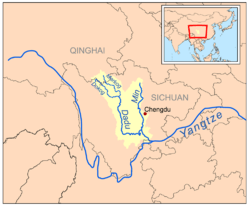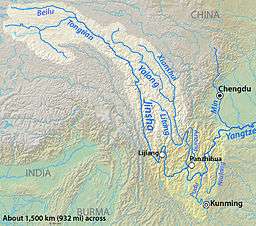Qiangic languages
| Qiangic | |
|---|---|
| Dzorgaic | |
| Geographic distribution: | China |
| Linguistic classification: |
|
| Glottolog: |
naqi1236 (Na–Qiangic)[1] qian1263 (Qiangic)[2] |
Qiangic (Ch'iang, Kyang, Tsiang), formerly known as Dzorgaic, is a group of related languages within the Sino-Tibetan language family. They are spoken mainly in Southwest China, including Sichuan, Tibet and Yunnan. Most Qiangic languages are distributed in the prefectures of Ngawa, Garzê, Ya'an, and Liangshan in Sichuan with some in northern Yunnan as well.
Qiangic speakers are variously classified as part of the Qiang, Tibetan, Pumi, Nakhi and Mongol ethnic groups by the Chinese government.
The extinct Tangut language, the official language of the Western Xia, has been determined to be a Qiangic language.
Languages
Sun (1983)
Sun Hongkai (1983)[3] proposes two branches, northern and southern:
- Northern: Northern Qiang (Máwō), Pumi (Prinmi), Muya (Minyag), Tangut (extinct; attested 1036–1502)
- Southern: Southern Qiang (Táopíng).
Sun groups other, poorly described Qiangic languages as:
- Ersu (Tosu), Shixing, Namuzi (Namuyi)
- Guiqiong (2–3 varieties with low intelligibility)
- Zhaba, Queyu.
Matisoff (2004)
Matisoff (2004) states that Jiarongic is an additional branch:
Thurgood and La Polla (2003)
Thurgood and La Polla (2003) state that the inclusion of Qiang, Prinmi, and Muya is well supported, but that they do not follow Sun's argument for the inclusion of Tangut. Matisoff (2004), however, claims Tangut demonstrates a clear relationship.[4] The unclassified language Baima may also be Qiangic or may retain a Qiangic substratum after speakers shifted to Tibetan.[5]
Some other lesser-known, unclassified Qiangic peoples and languages include the following:[6]
- Bolozi 玻璃哦子/博罗子: 2,000 people; in Xiao Heshui Village 小河水村, west of Songpan; also as far south as Wenchuan Township 汶川乡.[7] Sun Hongkai (2013:80-82)[8] identifies Bolozi 博罗子 as a Northern Qiang variety, belonging to the Cimulin 茨木林 dialect.
- Ming 命: 10,000 people; mixed Chinese in Mao County and Wenchuan County, Sichuan[9]
- Xiangcheng 乡城: 10,000 people in and around Xiangcheng Township 乡城, Garzê Prefecture[10][11]
Sun (2001)
Sun Hongkai (2001) groups the Qiangic languages are follows.
- Qiangic
Jacques & Michaud (2011)
Guillaume Jacques & Alexis Michaud (2011)[12] argue for a Na–Qiangic branch, which itself forms a Burmo-Qiangic branch together with Lolo–Burmese. Na–Qiangic comprises three primary branches, which are Ersuish (or Ersuic), Naic (or Naxish), and [core] Qiangic. Similarly, David Bradley (2008)[13] also proposed an Eastern Tibeto-Burman branch that includes Burmic (AKA Lolo-Burmese) and Qiangic. The position of Guiqiong is not addressed.
- Na–Qiangic
- Ersuish
- Naic
- Qiangic
- Queyu
- Zhaba (?)
- Tangut
- Pumi
- Northern Pumi
- Southern Pumi
- Muya
- Northern Muya
- Southern Muya
- Qiang
- rGyalrongic
- rGyalrongish
- Situ
- Japhug
- Tshobdun
- Zbu
- Lavrung
- Thugsrjechenmo
- Njorogs
- Horpa
- Rtau
- Stodsde
- rGyalrongish
Chirkova (2012)
However, Chirkova (2012)[14] casts doubt on the validity of Qiangic as a coherent branch, instead considering Qiangic to be a diffusion area. Chirkova considers the following four languages to be part of four separate Tibeto-Burman branches.
Both Shixing and Namuzi are both classified as Naic (Naxi) by Jacques & Michaud (2011), but Naic would not be a valid genetic unit Chirkova's classification scheme since Shixing and Namuzi are considered by Chirkova to not be part of a single branch.
Obsolete names
Shafer (1955) and other accounts of the Dzorgaic/Ch'iang branch[15] preserve the names Dzorgai, Kortsè, Thochu, Outer/Outside Man-tze, Pingfang from the turn of the century. The first three were Northern Qiang, and Outside Mantse was Southern Qiang.[16]
When Jiarongic is included as a branch of Qiangic, but distinct from the non-Jiarongic languages, the label "Dzorgaic" may be used for Qiang proper.
Hsi-fan (Xifan) is an ethnic name, meaning essentially 'Tibetan'; the people speak Qiangic or Jiarongic languages such as Qiang, Ergong/Horpa, Ersu, Guiqiong, Shixing, Zhaba, Namuyi, Muya/Minyak, and Jiarong, but not Naxi/Moso, Pumi, or Tangut. The term has not been much used since language surveys of the 1980s resulted in sufficient data for classification.
Distribution
Qiangic languages are spoken mainly in western Sichuan and northwestern Yunnan provinces of China. Sun Hongkai (2013) lists the following watersheds (riverine systems) and the respective Qiangic languages spoken there.[8]
- Upper Jialing River watershed 嘉陵江上游地区: Baima
- Min River watershed 岷江流域: Qiang (including Boluozi 博罗子)
- Dadu River watershed 大渡河流域: Guiqiong, Ersu
- Yalong River watershed 雅砻江流域: Ergong, Zhaba, Muya, Namuyi
- Jinsha River watershed 金沙江流域: Shixing, Pumi
|
See also
- Qiang people
- Ngawa Tibetan and Qiang Autonomous Prefecture#Languages
- Garzê Tibetan Autonomous Prefecture#Languages
References
- ↑ Hammarström, Harald; Forkel, Robert; Haspelmath, Martin; Bank, Sebastian, eds. (2016). "Na–Qiangic". Glottolog 2.7. Jena: Max Planck Institute for the Science of Human History.
- ↑ Hammarström, Harald; Forkel, Robert; Haspelmath, Martin; Bank, Sebastian, eds. (2016). "Qiangic". Glottolog 2.7. Jena: Max Planck Institute for the Science of Human History.
- ↑ Sun, Hongkai. (1983). The nationality languages in the six valleys and their language branches. Yunnan Minzuxuebao, 3, 99-273. (Written in Chinese).
- ↑ James Matisoff, 2004. "Brightening" and the place of Xixia (Tangut) in the Qiangic subgroup of Tibeto-Burman (Archived 2015-06-08 at WebCite)
- ↑ Katia Chirkova, 2008, "On the position of Báimǎ within Tibetan", in Lubotsky et al (eds), Evidence and Counter-Evidence, vol. 2.
- ↑ "China". asiaharvest.org.
- ↑ http://asiaharvest.org/wp-content/themes/asia/docs/people-groups/China/chinaPeoples/B/Bolozi.pdf
- 1 2 Sun Hongkai. 2013. Tibeto-Burman languages of eight watersheds [八江流域的藏缅语]. Beijing: China Social Sciences Academy Press.
- ↑ http://asiaharvest.org/wp-content/themes/asia/docs/people-groups/China/chinaPeoples/M/Ming.pdf
- ↑ http://asiaharvest.org/wp-content/themes/asia/docs/people-groups/China/chinaPeoples/X/Xiangcheng-OC.pdf
- ↑ http://asiaharvest.org/wp-content/themes/asia/docs/people-groups/China/chinaPeoples/X/Xiangcheng-PBW.pdf
- ↑ Jacques, Guillaume, and Alexis Michaud. 2011. "Approaching the historical phonology of three highly eroded Sino-Tibetan languages." Diachronica 28:468-498.
- ↑ Bradley, David. 2008. The Position of Namuyi in Tibeto-Burman.
- ↑ Chirkova, Katia (2012). "The Qiangic Subgroup from an Areal Perspective: A Case Study of Languages of Muli" (Archived 2015-06-08 at WebCite). In Languages and Linguistics 13(1):133-170. Taipei: Academia Sinica.
- ↑ Such as Barley (1997) (Archived 2015-06-08 at WebCite)
- ↑ UC Berkeley, 1992, Linguistics of the Tibeto-Burman Area, vol. 15, pp. 76–77.
Bibliography
- Bradley, David (1997). Tibeto-Burman languages and classification. In D. Bradley (Ed.), Papers in South East Asian linguistics: Tibeto-Burman languages of the Himalayas (No. 14, pp. 1–71). Canberra: Pacific Linguistics.
- Sun, Hongkai.(1983). The nationality languages in the six valleys and their language branches. Yunnan Minzuxuebao, 3, 99-273. (Written in Chinese).
- Sun Hongkai (Academy of Social Sciences of China Institute of Nationality Studies) (1990). "Languages of the Ethnic Corridor in Western Sichuan" (Archive" (Archive). Linguistics of the Tibeto-Burman Area, 13(1), 1-31. English translation by Jackson T.-S. Sun (University of California Berkeley and Academia Sinica).


